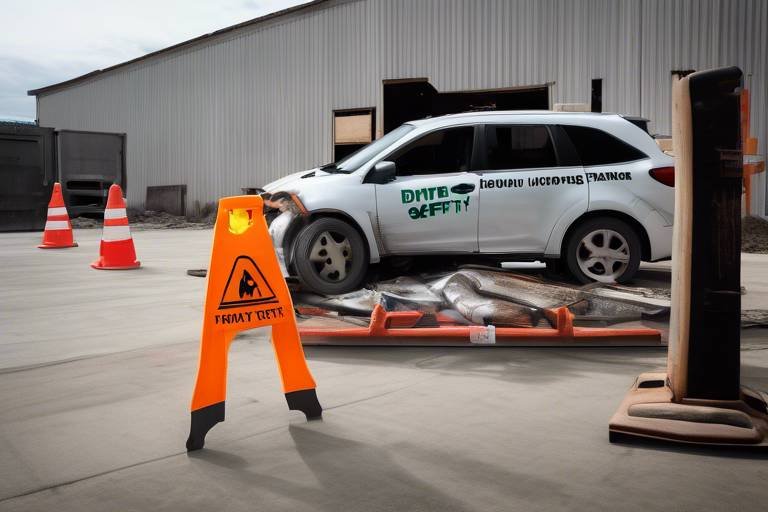Emphasizing the Role of Human Behavior in Safety Standards
In today's fast-paced world, where industries are constantly evolving, the significance of human behavior in shaping safety standards cannot be overstated. Imagine a bustling construction site, where heavy machinery whirs and workers bustle about. Amidst this chaos, the actions and decisions of individuals play a pivotal role in ensuring not just their safety, but also that of their colleagues. Understanding how psychological factors influence behavior is essential for organizations aiming to create a safer work environment.
Safety standards are often seen as mere regulations to follow, but they are much more than that. They are a reflection of the collective behavior and mindset of every employee in the organization. When individuals recognize the importance of adhering to safety protocols, the entire workplace benefits. This article delves into the intricate relationship between human behavior and safety standards, shedding light on how fostering a culture of safety can lead to enhanced compliance and a significant reduction in incidents.
Consider this: a company that prioritizes safety training and actively involves employees in safety discussions is not just following regulations; it is cultivating a proactive safety culture. This culture encourages employees to take ownership of their safety and the safety of their peers, creating an environment where everyone feels responsible and accountable. By understanding the behavioral aspects that drive compliance, organizations can implement strategies that resonate with their workforce, ultimately leading to a safer and more productive workplace.
Moreover, the role of leadership in shaping this culture is crucial. Leaders who model safe behaviors and demonstrate a genuine commitment to safety can inspire their teams to follow suit. When employees see their leaders prioritizing safety, they are more likely to adopt similar attitudes and behaviors. In essence, safety becomes a shared value, deeply embedded in the organizational fabric.
As we explore the various facets of human behavior in relation to safety standards, we will uncover the challenges organizations face and the strategies they can employ to overcome these hurdles. From resistance to change to the need for continuous learning, understanding these dynamics is key to fostering a culture that not only prioritizes safety but also enhances overall employee well-being.
- What are human factors in safety?
Human factors refer to the various psychological and behavioral elements that influence how individuals interact with their environment, particularly in relation to safety protocols and standards.
- How can behavioral safety programs improve workplace safety?
Behavioral safety programs focus on modifying employee behavior through training and reinforcement, leading to a safer work environment and reduced injury rates.
- What role does leadership play in promoting safety culture?
Leadership is crucial in modeling safe behaviors and demonstrating a commitment to safety, which inspires employees to adopt similar attitudes and practices.
- What are some common challenges in implementing safety standards?
Common challenges include resistance to change and lack of engagement from employees, which can hinder the successful adoption of safety initiatives.

The Importance of Human Factors in Safety
When we think about safety in various industries, it's easy to get lost in the technical details—like safety gear, machinery, and regulations. However, the real game-changer often lies in human behavior. Understanding how individuals interact with their environment is crucial for developing effective safety standards. After all, no matter how advanced a machine is or how comprehensive a safety protocol might be, if the people using them don't adhere to those standards, the potential for accidents remains high.
Human factors encompass a wide range of elements, including psychological, social, and physical aspects that influence behavior. For instance, consider a construction site where workers are required to wear helmets. If an employee feels invulnerable or believes that accidents won't happen to them, they may choose to forgo the helmet. This perception can lead to dangerous outcomes. Therefore, understanding these psychological underpinnings is essential for creating protocols that resonate with workers on a personal level.
Moreover, the environment plays a significant role in shaping behavior. A cluttered workspace or poorly lit area can increase the likelihood of accidents. Organizations must assess their environments and make necessary adjustments to promote safer behaviors. This could involve rearranging workspaces for better visibility or ensuring that safety equipment is easily accessible. The goal is to create an environment that encourages safe practices rather than hinders them.
To further illustrate the importance of human factors in safety, consider the following table, which outlines some key human-related elements that can impact workplace safety:
| Human Factor | Impact on Safety |
|---|---|
| Psychological State | Affects decision-making and risk perception |
| Training and Skills | Influences the ability to follow safety protocols |
| Work Environment | Can either promote or hinder safe practices |
| Communication | Essential for conveying safety information effectively |
Ultimately, promoting a culture of safety that acknowledges these human factors is vital. Organizations that prioritize understanding human behavior are more likely to see improvements in safety compliance and a reduction in incidents. It’s about creating a workplace where employees feel empowered to act safely, not just because they have to, but because they understand the importance of doing so.
So, how can organizations effectively incorporate these insights into their safety protocols? It starts with open communication, effective training, and a commitment to continuous improvement. By fostering an environment where employees feel valued and understood, businesses can significantly enhance their safety standards. In the end, it's not just about compliance—it's about cultivating a mindset that prioritizes safety at every level.

Behavioral Safety Programs
This article explores how human behavior impacts safety standards across various industries, highlighting the importance of understanding psychological factors and promoting a culture of safety to enhance compliance and reduce incidents.
Human factors play a crucial role in safety standards, influencing how individuals interact with their environment. Understanding these factors can lead to improved safety protocols and reduced accidents in workplaces.
Implementing can significantly enhance workplace safety. These programs are designed to modify employee behavior, focusing on the psychological aspects of compliance and safety. By understanding how people think and act in different situations, organizations can tailor their safety protocols to be more effective. This approach not only addresses the technical aspects of safety but also dives deep into the human psyche to foster a culture of safety.
At the heart of these programs is the idea that behavior modification can lead to a safer work environment. For instance, when employees are trained to recognize unsafe behaviors, they are more likely to adjust their actions accordingly. This proactive approach can drastically reduce injury rates and enhance overall safety. Behavioral safety programs typically include:
- Observation and Feedback: Regularly observing employee behaviors and providing constructive feedback helps reinforce safe practices.
- Positive Reinforcement: Recognizing and rewarding safe behaviors encourages employees to continue following safety protocols.
- Team Involvement: Engaging teams in safety discussions fosters a collaborative environment where everyone feels responsible for safety.
Moreover, the implementation of these programs requires a solid framework that includes training and education. Effective training equips employees with the necessary knowledge and skills to recognize hazards and respond appropriately. This educational component is essential for fostering a culture of safety. When employees understand the 'why' behind safety protocols, they are more likely to comply with them.
Effective training and education are essential components of behavioral safety programs. By providing employees with the necessary knowledge and skills, organizations can foster a culture of safety and encourage responsible behaviors. Training sessions should be interactive and engaging, allowing employees to participate actively. This involvement not only enhances learning but also builds a sense of ownership over safety practices.
Continuous learning initiatives help employees stay updated on safety practices and protocols. This ongoing education reinforces safe behaviors and adapts to new challenges in the workplace. For instance, regular workshops or refresher courses can keep safety top-of-mind, ensuring that employees are always aware of the latest safety standards and practices.
Encouraging peer-to-peer feedback fosters accountability among employees. This practice not only enhances safety awareness but also builds a supportive community focused on maintaining high safety standards. When employees feel comfortable giving and receiving feedback, it creates an environment where safety is prioritized, and everyone works together to ensure a safe workplace.
A strong safety culture promotes shared values and beliefs regarding safety in the workplace. Organizations that prioritize safety culture see increased employee engagement and commitment to following safety standards. By embedding safety into the core values of the organization, companies can create an environment where safety is not just a requirement but a fundamental aspect of daily operations.
Understanding the psychological factors that influence safety compliance is vital. Factors such as motivation, perception of risk, and social influences can significantly affect how employees adhere to safety protocols.
Motivation plays a key role in ensuring compliance with safety standards. Implementing incentives can encourage employees to prioritize safety and engage in safe practices consistently. When employees are rewarded for safe behavior, it reinforces the importance of safety and motivates them to maintain those behaviors.
Employees' perception of risk influences their behavior regarding safety. Addressing misconceptions and providing clear information can help improve their understanding and adherence to safety measures. By creating awareness about potential hazards and the importance of safety protocols, organizations can shift employees' perceptions towards a more safety-conscious mindset.
Implementing safety standards can present challenges, particularly when addressing human behavior. Identifying common obstacles and developing strategies to overcome them is essential for enhancing safety compliance.
Resistance to change is a common challenge when implementing new safety standards. Understanding the reasons behind this resistance can help organizations develop effective strategies for fostering acceptance and compliance. Communication is key; by clearly articulating the benefits of new safety measures, organizations can alleviate fears and encourage buy-in from employees.
Engagement is crucial for successful safety initiatives. Organizations must find ways to involve employees actively in safety discussions and decision-making processes to enhance commitment and compliance with safety standards. Creating forums for open dialogue about safety can help employees feel valued and invested in the safety culture.
Q1: What are behavioral safety programs?
A: Behavioral safety programs are initiatives designed to modify employee behaviors to enhance workplace safety, focusing on psychological factors and proactive measures.
Q2: How can training improve safety compliance?
A: Effective training equips employees with the necessary knowledge and skills, fostering a culture of safety and encouraging responsible behaviors.
Q3: Why is continuous learning important in safety programs?
A: Continuous learning helps employees stay updated on safety practices, reinforcing safe behaviors and adapting to new challenges in the workplace.
Q4: How can organizations overcome resistance to change in safety standards?
A: By clearly communicating the benefits of new safety measures and involving employees in the decision-making process, organizations can alleviate fears and encourage acceptance.

Training and Education
When it comes to enhancing safety standards in any workplace, are absolutely essential. Think of it as the foundation of a sturdy building; without a solid base, everything else is at risk of crumbling. Organizations that prioritize effective training programs not only empower their employees but also create a culture where safety is at the forefront of everyone's mind. But how do we ensure that our training programs are impactful and engaging?
First off, it's important to recognize that training isn't just a one-time event. It should be an ongoing process that evolves with the workplace and industry standards. This is where continuous learning comes into play. By regularly updating training materials and methods, organizations can keep their employees informed about the latest safety protocols and practices. For example, if a new piece of equipment is introduced, a comprehensive training session should be organized to familiarize employees with its safe operation. This not only helps in preventing accidents but also boosts employee confidence.
In addition to continuous learning, incorporating interactive training methods can significantly enhance the learning experience. Traditional lectures may not be the most effective way to engage employees. Instead, consider using hands-on training sessions, simulations, and even virtual reality experiences that allow employees to practice safety protocols in a controlled environment. This immersive approach helps them to internalize safety practices, making it more likely that they will apply what they've learned in real-world situations.
Moreover, fostering an environment where employees feel comfortable asking questions and sharing their experiences can lead to a more profound understanding of safety issues. Encouraging peer-to-peer learning can be a game-changer. When employees share their insights and learn from each other, it creates a supportive network that reinforces safety practices. For instance, if an employee has encountered a safety hazard, discussing it with peers can lead to collective problem-solving and improved safety measures.
To summarize, effective training and education are not just about ticking boxes; they are about creating a culture of safety that permeates every aspect of the workplace. By investing in ongoing training, utilizing interactive methods, and promoting peer learning, organizations can significantly enhance safety compliance and reduce incidents. After all, a well-trained employee is not just an asset to the organization; they are a cornerstone of a safe and productive work environment.
- What are the key components of an effective safety training program?
An effective safety training program should include clear objectives, interactive training methods, continuous learning opportunities, and a strong emphasis on peer-to-peer feedback.
- How often should safety training be conducted?
Safety training should be an ongoing process, with regular updates and refreshers scheduled at least annually, or more frequently when new equipment or protocols are introduced.
- What role does employee engagement play in safety training?
Employee engagement is crucial for the success of safety training. When employees are actively involved in discussions and decision-making, they are more likely to adhere to safety protocols and foster a culture of safety.

Continuous Learning
Continuous learning is not just a buzzword; it’s a fundamental pillar in creating a safe work environment. Imagine a world where employees are not only aware of safety protocols but are also actively engaged in updating and refining those protocols. This is the essence of continuous learning. It’s about fostering an atmosphere where learning is a part of the daily routine, allowing employees to stay on top of evolving safety practices and regulations.
In today’s fast-paced work environments, safety standards can change rapidly due to new technologies, regulations, or even lessons learned from past incidents. For instance, consider how quickly the landscape of workplace safety evolved during the COVID-19 pandemic. Organizations that had a culture of continuous learning were better equipped to adapt to new safety measures, ensuring the well-being of their employees. This adaptability is crucial, as it not only enhances compliance but also instills a sense of ownership among employees regarding their safety.
To effectively implement continuous learning in safety programs, organizations can adopt several strategies:
- Regular Training Sessions: Conducting frequent workshops and training sessions helps reinforce safety protocols and introduces employees to the latest practices.
- Safety Drills: Regularly scheduled safety drills ensure that employees are prepared for emergencies, enhancing their confidence and response times.
- Feedback Mechanisms: Establishing channels for employees to provide feedback on safety practices encourages ongoing dialogue and improvement.
- Use of Technology: Leveraging e-learning platforms and mobile applications can make training more accessible and engaging.
Moreover, organizations can create a culture of continuous learning by recognizing and rewarding employees who actively participate in training sessions and contribute to safety discussions. This not only boosts morale but also encourages others to engage in learning opportunities. Think of it as planting seeds of knowledge that will grow into a robust safety culture, where employees feel empowered to take charge of their own safety and that of their colleagues.
In conclusion, continuous learning is an ongoing journey, not a destination. It’s about being proactive rather than reactive. By embedding continuous learning into the fabric of workplace safety, organizations can cultivate a workforce that is not only knowledgeable but also passionate about maintaining high safety standards. This approach not only reduces incidents but also fosters a community where safety is a shared responsibility.
- What is continuous learning in the context of workplace safety?
Continuous learning in workplace safety refers to the ongoing process of educating employees about safety protocols, practices, and regulations to ensure they are always informed and prepared. - How can organizations promote continuous learning?
Organizations can promote continuous learning by offering regular training sessions, encouraging feedback, implementing safety drills, and utilizing technology for accessible learning. - Why is continuous learning important for safety compliance?
Continuous learning is crucial for safety compliance as it helps employees stay updated on the latest safety practices, reduces misunderstandings, and fosters a culture of accountability and responsibility.

Peer-to-Peer Feedback
In any workplace, the dynamics of human interaction significantly influence safety standards. One powerful tool that organizations can leverage to enhance safety is . This approach encourages employees to communicate openly about safety practices, fostering a culture of accountability and mutual support. Imagine a workplace where everyone feels empowered to speak up about unsafe behaviors or conditions—this is the essence of peer-to-peer feedback.
When employees engage in regular feedback with their colleagues, they create an environment where safety becomes a shared responsibility. This practice not only enhances awareness but also builds trust among team members. For instance, if one employee notices a coworker not wearing appropriate personal protective equipment (PPE), they can gently remind them to comply with safety standards. Such interactions can prevent accidents and reinforce the importance of adhering to safety protocols.
Moreover, peer-to-peer feedback can lead to improved morale and job satisfaction. When employees feel that their voices are heard and that they are part of a safety-conscious community, they are more likely to engage positively with safety initiatives. This sense of belonging can be likened to a safety net—where everyone looks out for one another, ensuring that no one falls through the cracks when it comes to safety.
To implement an effective peer-to-peer feedback system, organizations can consider the following strategies:
- Training Sessions: Conduct workshops that teach employees how to give and receive feedback constructively.
- Regular Check-Ins: Schedule routine meetings where safety discussions are encouraged, allowing employees to share their observations and suggestions.
- Recognition Programs: Acknowledge and reward employees who actively participate in promoting safety through feedback.
By fostering a culture where peer-to-peer feedback is not only accepted but encouraged, organizations can significantly enhance their safety standards. This approach not only reduces incidents but also cultivates a community where safety is prioritized, and everyone feels responsible for maintaining a safe work environment.
Q1: What is peer-to-peer feedback?
A1: Peer-to-peer feedback is a communication process where employees provide constructive feedback to each other regarding safety practices and behaviors in the workplace.
Q2: How does peer-to-peer feedback improve safety?
A2: It enhances safety by promoting accountability and awareness among employees, allowing them to remind and support each other in adhering to safety protocols.
Q3: What are some effective ways to encourage peer-to-peer feedback?
A3: Organizations can implement training sessions, regular safety meetings, and recognition programs to encourage employees to engage in feedback discussions.
Q4: Can peer-to-peer feedback affect employee morale?
A4: Yes, when employees feel supported and heard through feedback, it can lead to higher morale and job satisfaction, creating a more positive workplace atmosphere.

Creating a Safety Culture
Creating a robust safety culture within an organization is not just about adhering to regulations; it's about instilling a mindset that prioritizes safety at every level. Think of it as planting a garden—if you want it to thrive, you need to nurture it consistently. In this context, nurturing means fostering an environment where safety is everyone's responsibility, and employees feel empowered to speak up about potential hazards without fear of repercussions.
One of the key elements in cultivating this culture is leadership commitment. When leaders model safe behaviors and prioritize safety in their decision-making, it sets a powerful example for the entire organization. Employees are more likely to follow suit when they see their leaders actively engaging in safety practices. Moreover, recognizing and rewarding safe behaviors can reinforce this commitment. For instance, a simple acknowledgment in a team meeting can go a long way in motivating others to adopt similar practices.
Furthermore, communication plays a pivotal role in developing a safety culture. Open lines of communication encourage employees to voice their concerns and share ideas for improving safety protocols. Regular safety meetings can serve as a platform for discussing safety issues and brainstorming solutions. It’s crucial that these meetings are not just formalities but are treated as valuable opportunities for collaboration. Employees should feel that their input is valued, which can significantly enhance their engagement and commitment to safety.
Another effective strategy is implementing peer observation programs. This approach allows employees to observe each other’s work practices, providing constructive feedback and promoting accountability. By participating in these programs, employees become more aware of their behaviors and the impact they have on safety. It’s like having a buddy system—when you know someone is watching your back, you tend to be more cautious and diligent.
Lastly, continuous education and training are essential for reinforcing a safety culture. It’s not enough to conduct a one-time training session; safety practices must be revisited regularly to keep them fresh in everyone’s mind. This could involve hands-on training, workshops, or even online courses that allow employees to learn at their own pace. The goal is to create an environment where learning about safety is ongoing and evolving, much like the challenges that arise in the workplace.
In summary, creating a safety culture is a multifaceted endeavor that requires commitment, communication, peer support, and continuous learning. By fostering an environment where safety is prioritized and valued, organizations can significantly reduce incidents and enhance overall workplace morale. After all, when safety becomes part of the organizational identity, everyone benefits—employees feel safer, productivity increases, and the organization thrives.
- What is a safety culture? A safety culture refers to the shared values, beliefs, and behaviors regarding safety within an organization. It emphasizes the importance of safety at all levels.
- How can leadership influence safety culture? Leaders can influence safety culture by modeling safe behaviors, prioritizing safety in decision-making, and actively engaging with employees about safety practices.
- Why is communication important in safety culture? Open communication allows employees to voice concerns, share ideas, and collaborate on safety improvements, fostering a more engaged and proactive workforce.
- What role does training play in safety culture? Continuous training ensures that employees are updated on safety practices and reinforces the importance of adhering to safety protocols.

Psychological Aspects of Safety Compliance
Understanding the psychological factors that influence safety compliance is not just a nice-to-have; it's a necessity for organizations aiming to create a safer work environment. When we think about safety, we often focus on rules, regulations, and protocols. But what about the human element? How do our thoughts, feelings, and motivations shape our adherence to these standards? The truth is, human behavior is at the heart of safety compliance, and by delving into the psychological aspects, we can uncover ways to enhance our safety practices.
One of the most significant psychological aspects is motivation. When employees feel motivated to follow safety protocols, compliance rates soar. But what drives this motivation? It can stem from various sources, including personal values, organizational culture, and even incentives. For instance, when a company offers rewards for safe practices, it not only recognizes employees' efforts but also encourages a mindset where safety becomes a priority. This leads to a ripple effect, where individuals are not just following rules but are genuinely invested in maintaining a safe work environment.
Another critical factor is the perception of risk. How employees perceive potential dangers can greatly influence their behavior. If they underestimate risks, they may neglect safety protocols, thinking, "It won't happen to me." To combat this, organizations must provide clear and consistent information about risks and safety measures. Educational initiatives can help reshape perceptions and create a culture where safety is seen as paramount. For example, conducting regular workshops that highlight real-life incidents and their consequences can open eyes and foster a deeper understanding of the importance of compliance.
Additionally, social influences play a pivotal role in shaping safety behaviors. Employees are often affected by their peers; if they observe coworkers disregarding safety measures, they may feel inclined to do the same. This is where fostering a strong safety culture becomes essential. When organizations prioritize safety and create an environment where everyone holds each other accountable, compliance improves. Employees should feel empowered to speak up about unsafe practices, knowing they are part of a community that values safety above all.
To summarize, the psychological aspects of safety compliance are multifaceted. By addressing motivation, perception of risk, and social influences, organizations can create a more robust safety culture. This, in turn, leads to enhanced compliance, fewer incidents, and a healthier workplace overall. Remember, when it comes to safety, it’s not just about the rules; it’s about the people who follow them.
- What are the main psychological factors affecting safety compliance?
Motivation, perception of risk, and social influences are key psychological factors that impact how employees comply with safety standards. - How can organizations improve employee motivation towards safety?
By implementing incentives and recognizing safe behaviors, organizations can boost motivation and encourage a culture of safety. - Why is perception of risk important in safety compliance?
Employees' understanding of potential hazards influences their behavior; a clear perception of risk leads to better adherence to safety protocols. - How can social influences affect safety behaviors?
Employees often look to their peers for cues on behavior; a strong safety culture encourages accountability and promotes safe practices.

Motivation and Incentives
Motivation is the driving force behind our actions, and when it comes to workplace safety, it plays a pivotal role in ensuring compliance with safety standards. Think of it as the engine of a car; without it, the vehicle simply won’t move. In the context of safety, motivated employees are more likely to follow protocols, report unsafe conditions, and engage in safe practices. But how can organizations effectively boost motivation to enhance safety compliance?
One effective way to increase motivation is through incentive programs. These programs can take various forms, from monetary rewards to recognition initiatives. For instance, consider a scenario where employees are rewarded for achieving safety milestones. This could include:
- Bonuses for teams that go a certain number of days without incidents.
- Acknowledgment in company meetings or newsletters for individuals who consistently adhere to safety practices.
- Gift vouchers or other perks for departments that demonstrate exemplary safety records.
By implementing these incentive programs, organizations not only encourage safe behaviors but also foster a sense of competition among employees. This healthy competition can lead to a more engaged workforce, where everyone is striving to meet safety standards and contribute to a safer workplace.
Moreover, it’s essential to align these incentives with the specific goals of the organization. For example, if an organization aims to reduce slips and falls, creating a targeted incentive program that rewards employees for identifying potential hazards can be incredibly effective. This not only motivates employees to be vigilant but also empowers them to take ownership of their safety and the safety of their colleagues.
However, it’s crucial to remember that motivation isn’t solely about financial rewards. Recognition and appreciation can have a profound impact on an employee's motivation levels. When employees feel valued and recognized for their efforts, it boosts their morale and encourages them to maintain high safety standards. As the saying goes, “People don’t care how much you know until they know how much you care.” This is especially true in the realm of workplace safety.
In conclusion, motivation and incentives are fundamental components of a successful safety strategy. By creating an environment where employees are recognized for their safe behaviors and are motivated to adhere to safety protocols, organizations can significantly enhance their safety culture. A motivated workforce not only leads to fewer incidents but also contributes to a more engaged and productive workplace overall.
- What are some effective ways to motivate employees regarding safety? Incentive programs, recognition initiatives, and fostering a supportive community can effectively motivate employees to prioritize safety.
- How can organizations measure the success of their safety motivation programs? Organizations can track incident rates, employee feedback, and participation levels in safety initiatives to assess the effectiveness of their programs.
- Why is recognition important in safety compliance? Recognition boosts employee morale and reinforces safe behaviors, making employees feel valued and encouraging them to maintain high safety standards.

Perception of Risk
The is a fundamental aspect that shapes how employees approach safety in the workplace. It’s fascinating to think about how our minds interpret potential dangers. For instance, if someone believes that a specific task is inherently risky, they are more likely to take precautions, while someone who underestimates the hazards may disregard safety protocols altogether. This discrepancy can lead to significant differences in behavior and compliance with safety standards.
One of the key factors influencing perception of risk is experience. Employees who have previously encountered accidents or near-misses are often more cautious. Conversely, those who have never faced any issues might feel invulnerable, leading them to take unnecessary risks. This phenomenon can create a dangerous cycle where the lack of immediate consequences reinforces risky behavior, ultimately putting the entire workplace at risk.
Additionally, communication plays a crucial role in shaping risk perception. When organizations effectively communicate the dangers associated with specific tasks, employees are more likely to understand the risks involved. For example, consider a construction site where safety briefings highlight the potential hazards of working at heights. Clear communication can transform a worker's mindset, making them more vigilant and compliant with safety measures.
Moreover, social influences cannot be overlooked. Employees often look to their peers for cues on how to behave. If a culture of safety is prevalent, where colleagues consistently prioritize safety, individuals are more likely to adopt similar attitudes. On the other hand, if risky behaviors are normalized, even the most safety-conscious individuals may begin to lower their guard.
To illustrate the impact of perception of risk, consider the following table that summarizes different factors affecting risk perception:
| Factor | Influence on Risk Perception |
|---|---|
| Experience | Previous encounters with hazards increase caution. |
| Communication | Clear and consistent messaging enhances understanding of risks. |
| Social Influence | Peer behavior shapes individual risk-taking tendencies. |
| Training | Education on safety protocols improves risk awareness. |
Addressing the perception of risk requires a multifaceted approach. Organizations must invest in training programs that not only educate employees about safety protocols but also emphasize the importance of recognizing and assessing risks. By fostering an environment where employees feel comfortable discussing safety concerns, organizations can significantly enhance their overall safety culture.
In conclusion, understanding the perception of risk is vital for improving safety compliance. By addressing the psychological factors that influence how employees view risks, organizations can create a more informed and vigilant workforce, leading to a safer workplace for everyone.
- What is the perception of risk? The perception of risk refers to how individuals interpret and respond to potential dangers in their environment.
- How does experience affect risk perception? Previous experiences with hazards can lead to increased caution, while a lack of such experiences may result in underestimating risks.
- Why is communication important in shaping risk perception? Effective communication helps employees understand the dangers associated with tasks, leading to better safety practices.
- What role do social influences play in risk behavior? Employees often model their behavior based on their peers, making it essential to foster a culture of safety.

Challenges in Implementing Safety Standards
Implementing safety standards can be a daunting task, especially when it comes to addressing the intricacies of human behavior. One of the most significant challenges organizations face is resistance to change. When new safety protocols are introduced, employees may feel overwhelmed or skeptical about the necessity of these changes. This resistance often stems from a fear of the unknown or a belief that current practices are sufficient. To combat this, organizations need to understand the underlying reasons for this resistance. For instance, providing clear communication about the benefits of new safety measures can help alleviate fears and foster a more accepting attitude.
Another challenge is the lack of engagement among employees. If workers do not feel involved in the safety discussions or decision-making processes, they are less likely to buy into the safety culture being promoted. Engagement is crucial because it fosters a sense of ownership and accountability. Organizations can enhance engagement by actively involving employees in safety committees or by soliciting their input during safety training sessions. When employees see that their opinions matter, they are more likely to commit to adhering to safety standards.
Moreover, the inconsistent application of safety standards can create confusion and frustration among employees. If safety protocols are not uniformly enforced, workers may perceive them as arbitrary or unnecessary. This inconsistency can lead to a culture where safety is viewed as optional rather than essential. To address this, organizations should ensure that all employees receive the same training and that safety standards are applied uniformly across all departments. Regular audits and assessments can help identify areas where inconsistencies may exist, allowing organizations to rectify them promptly.
In addition to these challenges, organizations must also contend with the dynamic nature of the workplace. As industries evolve and new technologies emerge, safety standards must adapt accordingly. This constant change can be overwhelming for employees, especially if they are not provided with adequate training and resources. Continuous education initiatives can play a vital role in helping employees stay informed about the latest safety practices and protocols. By fostering a culture of continuous learning, organizations can ensure that their workforce is prepared to navigate the ever-changing landscape of workplace safety.
Lastly, compliance fatigue can set in when employees feel overwhelmed by the number of safety protocols they are required to follow. This fatigue can lead to complacency, where employees may begin to overlook or ignore safety measures. Organizations need to be aware of this phenomenon and take steps to simplify safety protocols where possible. Streamlining procedures and providing clear, concise guidelines can help mitigate compliance fatigue and encourage employees to remain vigilant about safety.
In summary, while implementing safety standards is essential for creating a safe work environment, it comes with its own set of challenges. By addressing resistance to change, fostering engagement, ensuring consistent application of standards, adapting to workplace dynamics, and combating compliance fatigue, organizations can enhance their safety initiatives and promote a culture of safety that benefits everyone.
- What are the main challenges in implementing safety standards? The main challenges include resistance to change, lack of engagement, inconsistent application of standards, adapting to dynamic workplaces, and compliance fatigue.
- How can organizations overcome resistance to change? Organizations can overcome resistance by providing clear communication about the benefits of new safety measures and involving employees in the decision-making process.
- Why is employee engagement important in safety initiatives? Employee engagement fosters a sense of ownership and accountability, making workers more likely to adhere to safety standards.
- What role does continuous education play in workplace safety? Continuous education helps employees stay informed about the latest safety practices, ensuring they are prepared to adapt to changes in the workplace.

Resistance to Change
Resistance to change is a common phenomenon in many organizations, especially when it comes to implementing new safety standards. Imagine introducing a new safety protocol that requires employees to alter their daily routines. Naturally, there will be a mix of skepticism and apprehension. Why? Because change often disrupts the comfort zone that individuals have built over time. The fear of the unknown can lead to a reluctance to embrace new practices, even if they are designed to enhance safety.
One of the primary reasons for this resistance is the fear of failure. Employees may worry that they won’t be able to adapt to the new standards or that they will make mistakes in the process. This fear can be paralyzing and may cause individuals to cling to old habits, even when they are aware that these habits are not the safest options. To combat this, organizations need to provide robust support systems, including training and resources, to ease the transition.
Another significant factor contributing to resistance is the lack of involvement in the decision-making process. When employees feel excluded from discussions about safety changes, they may perceive these changes as imposed rather than collaborative. This sense of alienation can lead to a lack of buy-in, making it challenging to implement new safety measures effectively. To foster a culture of acceptance, organizations should encourage open communication and actively involve employees in the development of safety protocols.
Moreover, addressing the emotional aspects of change is crucial. Change can stir up feelings of anxiety and uncertainty. Organizations can mitigate these feelings by implementing strategies such as:
- Providing clear and consistent communication about the reasons for the changes.
- Highlighting the benefits of the new safety measures, not just for the organization, but for the employees themselves.
- Offering support through mentoring or buddy systems during the transition period.
In conclusion, overcoming resistance to change requires a multifaceted approach. By understanding the root causes of this resistance, organizations can implement strategies that not only facilitate compliance but also promote a culture of safety and engagement. The journey towards enhanced safety standards may be challenging, but with the right mindset and approach, it can lead to a more secure and supportive workplace environment.
- What are some common reasons for resistance to change in safety protocols?
Common reasons include fear of failure, lack of involvement in decision-making, and emotional anxiety related to the unknown.
- How can organizations effectively manage resistance to change?
Organizations can manage resistance by providing clear communication, involving employees in the process, and offering support during transitions.
- What role does employee engagement play in implementing safety standards?
Employee engagement is crucial as it fosters a sense of ownership and commitment to safety standards, leading to better adherence and compliance.

Lack of Engagement
When it comes to workplace safety, one of the most significant hurdles organizations face is the from employees. It's like trying to drive a car without fuel; no matter how well-designed the vehicle is, it just won't go anywhere. Employees who feel disconnected from safety initiatives are less likely to prioritize safety in their daily routines. This disengagement can stem from various factors, including poor communication, lack of recognition, or simply feeling that their input doesn't matter.
Imagine a scenario where safety meetings are held, but they feel more like a lecture than a collaborative discussion. Employees might sit through these sessions, nodding along, but their minds are elsewhere. They might think, "Why should I care? This doesn't affect me." This mindset can lead to a culture where safety is viewed as a box to be checked rather than a core value. To combat this, organizations need to actively involve employees in safety discussions and decision-making processes. When individuals feel their voices are heard, their engagement levels can skyrocket.
To foster a culture of engagement, organizations can implement several strategies:
- Open Communication: Create an environment where employees feel comfortable voicing their concerns and suggestions regarding safety practices.
- Recognition Programs: Celebrate safety milestones and recognize individuals who contribute to a safer work environment. A simple "thank you" can go a long way.
- Interactive Training: Move away from traditional training methods and incorporate interactive elements, such as workshops or role-playing scenarios, to make learning about safety more engaging.
Moreover, engaging employees in safety initiatives can lead to a sense of ownership. When employees feel responsible for their safety and that of their colleagues, they are more likely to adhere to safety protocols. This sense of ownership transforms safety from a mere obligation into a personal commitment. For instance, consider the impact of a safety committee composed of employees from various departments. This committee can serve as a platform for discussing safety issues, sharing ideas, and developing solutions collaboratively. Such initiatives not only enhance safety compliance but also strengthen team dynamics.
In summary, addressing the lack of engagement in safety initiatives is crucial for fostering a culture of safety. By prioritizing open communication, recognizing contributions, and incorporating interactive training, organizations can transform their approach to safety. When employees are engaged, they not only comply with safety standards but also become advocates for a safer workplace, creating a ripple effect that benefits everyone.
Q1: How can we improve employee engagement in safety initiatives?
A1: Improving engagement can be achieved through open communication, recognition programs, and interactive training methods that involve employees in the safety process.
Q2: What are some signs of disengagement among employees regarding safety?
A2: Signs of disengagement can include lack of participation in safety meetings, minimal feedback on safety protocols, and a general apathy towards safety practices.
Q3: Why is employee ownership important in safety compliance?
A3: Employee ownership fosters accountability and commitment, leading to higher adherence to safety protocols and a proactive approach to identifying and mitigating risks.
Frequently Asked Questions
- What are human factors in safety standards?
Human factors refer to the psychological, physical, and social aspects that influence how individuals behave in a workplace. Understanding these factors helps organizations develop better safety protocols, leading to fewer accidents and a safer work environment.
- How do behavioral safety programs improve workplace safety?
Behavioral safety programs focus on changing employee behaviors through training and reinforcement. By educating employees on safe practices and encouraging accountability, these programs create a culture of safety that significantly reduces injury rates.
- What role does training play in safety compliance?
Training is crucial for ensuring that employees understand safety protocols and the importance of compliance. Effective training equips workers with the knowledge and skills they need to make safe decisions, ultimately fostering a stronger safety culture.
- Why is continuous learning important in safety programs?
Continuous learning keeps employees updated on the latest safety practices and protocols. This ongoing education not only reinforces safe behaviors but also helps workers adapt to new challenges, ensuring that safety remains a priority.
- How does peer-to-peer feedback enhance safety?
Peer-to-peer feedback encourages employees to hold each other accountable for safety practices. This collaborative approach builds a supportive community, increases safety awareness, and helps maintain high safety standards in the workplace.
- What psychological factors influence safety compliance?
Factors like motivation, risk perception, and social influences play a significant role in how employees adhere to safety protocols. Understanding these psychological aspects can help organizations tailor their safety initiatives to improve compliance.
- How can motivation and incentives improve safety practices?
Motivation is key to ensuring that employees prioritize safety. By implementing incentives for safe behaviors, organizations can encourage employees to consistently engage in practices that uphold safety standards.
- What challenges do organizations face when implementing safety standards?
Common challenges include resistance to change and lack of employee engagement. Addressing these issues is vital for enhancing safety compliance, and organizations must develop strategies to foster acceptance and involvement.
- How can organizations overcome resistance to change in safety standards?
Understanding the reasons behind resistance is essential. Organizations can address concerns through open communication, providing clear information, and involving employees in the decision-making process to foster a more accepting environment.
- What strategies can increase employee engagement in safety initiatives?
To boost engagement, organizations should actively involve employees in safety discussions, solicit their input on safety practices, and recognize their contributions. This inclusion fosters a sense of ownership and commitment to safety standards.



















